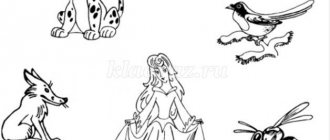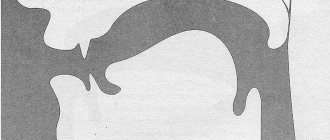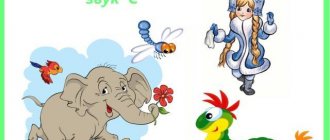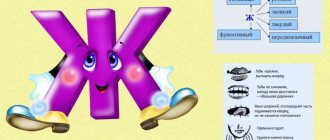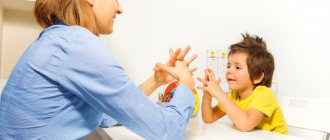Summary of individual speech therapy sessions. Automation of sound Ш
Summary of an individual speech therapy lesson on sound automation [Ш] for a child 5-6 years old
Author: Ponomareva Tatyana Aleksandrovna, teacher-speech therapist of the Municipal Preschool Educational Institution "Kindergarten No. 166 "Swallow", Saratov
Synopsis of an individual speech therapy lesson on sound automation [Ш] "Road" for Masha"
Description of the material: I offer you a summary of a lesson on sound automation [Ш] for children of senior preschool age (5-6 years old). This material will be useful to kindergarten speech therapists. This summary is for the stage of sound automation in syllables, words, sentences and poems. Form of delivery: individual lesson. Equipment: Masha doll, box, object pictures with sound [Ш], pictures with tasks, illustrations for poems. Goal: automation of sound [Ш] Objectives: a) correctional: to develop clear and differentiated movements of the articulatory apparatus; learn to pronounce the sound [Ш] in isolation, in syllables, words, sentences, poems; clarify the acoustic and pronunciation image of the sound [Ш], b) developmental: develop phonemic processes, memory, attention, motor skills; improve lexical and grammatical categories; c) educational: to cultivate a desire to help a friend, a desire to speak beautifully and correctly, and to create positive motivation in class. Progress of the lesson: I. Organizational moment. — On the way here I met the doll Masha. She forgot the way home. Let's take her home to her mom? Okay, I just know which path we need to take. And to make it more fun, we will perform different tasks along the way. II. Main part. 1. Articulation gymnastics. - Let's teach Masha to do the following exercises: “Fence/Tube” - 5 times. “Delicious jam” - 5 times. “Swing” - 10 times. “Cup” - 10 seconds. “Mushroom” - 5 seconds. “Horse” - 5 times. 2. Repetition of articulation of sound [Ш]
- Look, it’s crawling along the path and hissing! Let's hiss just like him. Now move your finger along the path and hiss. Now move your pencil and don’t forget to hiss like a snake. — Tell Masha how we pronounce the sound [Ш]. What do our tongue, lips, teeth do when pronouncing the sound [Ш]? (lips are rounded, teeth are closed with a small gap, the tongue looks like a “cup” and is raised by the tubercles behind the upper teeth). 3. Automation of sound in syllables. - Look, there are footprints on this path. Let's read what it says there. Shi-shu-sho Sha-she-shu Shu-sho-sha Shto-shty-shta Shto-shtu-shta Shko-shtu-shku Shko-shko-shku Shwe-shva-schvu Shwe-shty-shta 4. Finger gymnastics. “Little Frog” I will connect the ring finger, the middle one, with the big one. I’ll bend the other two back and show Little Frog. 5. Automation of sound in words. a) “Name the word and determine the place of the sound.”
- What is this box on the path?
Look what's in it. - Name the words and arrange the pictures accordingly: with the sound [Ш] at the beginning of the word, in the middle and at the end of the word. (Subject pictures: fur coat, chamomile, scarf, shirt, shower, wardrobe, cat, mouse, reeds, chess). b) “Count.”
-Who is that sleeping in the clearing? (Cat). Who does a cat see in her dream? (Mice). Count how many mice the cat saw in her dream. (One mouse, two mice, three mice...)
6. Automation of sound in sentences. - Match the action words with suitable pictures. Make up and speak sentences. Let's find out what Masha did. (Masha ate a chocolate bar. Masha ate a pear. Masha ate a cherry. Masha washed a pear. Masha saw a school. Masha went up to the school. Masha was embroidering a pillow. Masha bought a chocolate bar. Masha was hemming her shorts. Masha was ironing her shorts.)
7. Automation of sound in poems.
The cockerel found the bag. And there was a pot in the bag. And in the pot there are peas and a few crumbs.
Reeds rustled in the darkness. The cat thought it was a mouse. She ran into the reeds - There is not a soul in the reeds. III. Summarizing. “But I can see whose house is hidden behind the reeds.” Here we are. Masha says thank you. You took her home and taught her to pronounce the sound [Ш]. How do we pronounce the sound [Ш]? Remember who we met along the way? Well done! Today you tried and pronounced the sound correctly and helped the doll Masha find her way home.
We recommend watching:
Summary of educational activities in a compensatory preparatory group for children with severe speech impairments. Summary of individual lessons in a secondary speech therapy group on the topic “Automation of sound C.” Summary of educational activities in a senior compensatory group for children with severe speech impairments. 3 Summary of individual speech therapy sessions. Automation of sound L
Similar articles:
Lesson notes for a senior speech therapy group. Sound K
Summary of a speech therapy session with primary school children diagnosed with ODD
Summary of GCD for children of the senior speech therapy group
Summary of a speech therapy session with children 5-6 years old with mental retardation
Summary of educational activities in the older group of children with severe speech impairments on the topic: “Sounds S - Z”
Automation of the sound Ш in sentences of 3 words:
Our hut is good. Masha, eat some porridge. Misha eat chocolate. Grandma is embroidering a cockerel. A tractor driver plows the arable land. I hurt my neck. Natasha writes in ink. The horse walked at a walk. Masha eats stew. If you lose it, you won't find it. Misha writes well.
OBJECTIVES: 1. Clarify the pronunciation of the existing sound “SH”. Achieve correct pronunciation of the isolated sound “Ш”. Learn to determine the position of the lips and tongue when pronouncing the sound “Ш” 2. Automate the sound in speech. Teach the child to correctly pronounce and articulate this sound in straight syllables, in words with straight syllables with stress on the syllable, in poetry and in phrasal speech. 3. Development of phonemic awareness. Distinguishing the sound “Ш” in a series of sounds. The ability to hear and identify sounds in words. 4. Development of memory, auditory attention: bringing linear memory to 4 units. Learn to memorize words in a given order. 5. Development of fine motor skills of the hands by influencing the active points of the palms with a su-jok ball.
VISUAL MATERIAL. 1. Toys whose names contain the sound “SH” (cat...). 2. Subject pictures: hat, cat, T-shirt, washer, shampoo, towel, fur coat, pipe, car, basket.
PROGRESS OF THE LESSON 1. Organizational moment Show the child a toy (cat). The word cat has the sound "sh". - We will learn to pronounce this sound correctly. Hiss like a cat: Sh-Sh-Sh... Show the child a toy (snake). Let's sing the snake song. Say the sound “Sh” for a long time with one exhalation: Sh-Sh-Sh...
Clarify the articulatory structure. - Let's remember where the sound “Ш” lives, the tongue at the top, resembles a “cup shape”. The lips are rounded and slightly pushed forward, the teeth are close together but do not touch, the tip of the tongue is wide, raised to the palate (behind the alveoli), but does not touch it, forming a gap. The lateral edges are pressed from the inside to the upper molars, not allowing a stream of exhaled air to pass along the sides.
2. Syllable warm-up. - Let's play, I tell you the syllables, and you clearly repeat after me: Sha-sha-sha Shi-shi-shi Asha-asha-asha Ashi-ashi-ashi Sho-sho-sho Shu-shu-shu Asho-asho- asho Ashu-ashu-ashu She-she-she She-ashe-ashe
3. Automation in words with straight syllables, with emphasis on the syllable with the sound “Ш”. - Now, let's sing a song: sha-sha-hat sha-sha-puck sha-sha-chess sha-sha-shampoo sha-sha-mine sha-sha-step sha-sha-champignon sha-sha-stir sha- sha-ushanka sha-sha-breathe sha-sha-decide sha-sha-horse sho-sho-seam sho-sho-whisper sho-sho-bag sho-sho-fluff sho-sho-pot sho-sho-top sho- sho-cock sho-strap sho-sho-mouse
Shu-shu-noise Shu-shu-joke Shu-shu-joke Shu-shu-joking Shu-shu-skimmer Shu-shu-joker Shu-shu-fur coat Shu-shu-make noise shi-shi-screen shi-shi-jug shi-shi-car She-she-neck She-she-whisper She-she-target She-she-whisper She-she-breathe She-she-beg She-she-carry shi-shi-tire ashi-shi-spikes shi-shi-sew shi-shi-thorn shi-shi-sewing shi-shi-sizzle shi-shi-rosehip shi-shi-shilo
4. Automation of the sound “Ш” in phrasal speech. - Let's play the game "Parrot." I say a phrase, and you repeat after me. Dasha has chess. Masha eats stew. Yasha has millet porridge. Yasha's car has tires. Natasha hangs her fur coat in the closet. The cat has ears on the top of its head. Pasha rolls a bear on a car. Chess and checkers are in Dasha's closet. The naughty ones were making noise and playing pranks. Someone hisses under the rose hips. It is convenient to remove the champignons with a slotted spoon. The minx tore her shorts. Shura has wide trousers. The driver needs to check the tires. Miners extract coal at the mine.
5. Finger gymnast. A poem using Su-jok technology. - Now listen to the new poem “Our Masha” Our Masha got up early, counted all the dolls: Two nesting dolls on the window, Two Tanya on the pillow. - Take a magic ball, roll it between your palms and pronounce this poem with me clearly and correctly.
Development of phonemic awareness and auditory attention. (Working with an object picture). (Words with the sound “Ш” in different positions). - Look at the pictures and name what is shown there. “Now I’ll name the words, you clap your hands if you hear the sound “SH.” Pictures: hat, cat, T-shirt, washer, shampoo, towel, fur coat, pipe.
6. Development of memory, auditory attention. “And now I’ll tell you a few words in a row, and you try to remember them and repeat them, be careful!” Noise-joke-fur-cat
7. Summary of the lesson. “You’ve done well today, and you’ve learned to pronounce the sound “Sh” clearly and correctly.” You worked hard and deserve a sticker as a reward! Homework: learn the poem “Our Masha.”
MAGAZINE Preschooler.RF
Correctional educational goals: • Practice correct pronunciation of the sound “Ш” in syllables, words and sentences. • Strengthen the ability to use models when analyzing the characteristics of sounds. • Clarify and expand the vocabulary through the formation of the semantic field of the word “MOUSE” • Develop the function of inflection.Corrective and developmental goals: • Develop articulatory motor skills, long speech exhalation, phonemic awareness, memory, attention, self-control. Correctional and educational goal of the lesson: • To cultivate interest in learning activities, perseverance, and accuracy in work.
Equipment: mirror, cards for analyzing articulation and sound characteristics, sound models and the image of the letter “Ш”, pictures for the sound “Ш”, image: mice, Mouse toy, chips. Progress of the lesson 1. Org. moment. Speech therapist: Listen to the riddle: - A little baby, afraid of a cat, lives in a hole, carries everything there. -Who is this? - Mouse. A picture is displayed - “MOUSE” - What sound does this word end with? – With the sound “SH” – Today we will work on the correct pronunciation of this sound. And in order to speak this sound correctly, the lips, tongue and jaws must work well. 2. Speech therapy exercises articulation exercises: “Pancake, Cup, Turkey, Coil” development of mobility of the lower jaw Speech therapist: how does a mouse chew a hard crust? Tense and relaxed chewing movements Speech therapist: how does a mouse chew soft cheese? Work on speech exhalation Speech therapist: let's say as we exhale: Ah, delicious cheese... Ah, delicious fragrant cheese... 3. Analysis of the acoustic-articulatory image of the sound “Ш” (reliance on the table). Speech therapist: Pronouncing the isolated sound “Ш” with the connection of oral, tactile, visual and acoustic control Characteristics of the sound “Ш” and correlating it with the letter “Sha” Speech therapist: What is the difference between the sound “Ш” and the letter “Sha”? The sound is consonant, dull, hard (Why do you think so?) 4. Automation of the sound “Ш” in syllables (syllable tracks). Speech therapist: Help the mouse run to the hole (Picture with a mouse running along the path to the hole A, O, U, I and back). The children pronounce the syllable rows in chorus: Sh—-A, Sh—-O, Sh—U, Sh—I, A—Sh, O—Sh, U—Sh, I—Sh, 5. Automation of the sound “Sh” in words and phrases. There are pictures on the carpet, the speech therapist invites the children to choose only those with the sound “SH” and name them (cat, mouse, donut, closet, mousetrap, skin) - the pictures are displayed on the easel. Selection of cognate words.
Speech therapist: Listen to the words and put down as many chips as the number of times you hear the word “MOUSE” (Mouse, Mouse, Mouse, Mousetrap, Mouse, Mouse). Speech therapist: How many chips did you put in? Speech therapist: Repeat the words and explain the meaning of the words: mousetrap (trap for a mouse), mousetrap (hunt a mouse). Speech therapist: Choose a definition word for our words (What kind of mouse? - big, fluffy; What kind of mouse? - tiny, playful; What kind of mousetrap? - noisy, big; What kind of fur? - mousey, fluffy) 6. Development of the inflection function. Speech therapist: Mouse one, mouse two, we will count the words. Let's change our words, answering the question - How much? The speech therapist sets the numbers: 1, 2, 6 and asks each child to count the phrase (One big fluffy mouse, two big fluffy mice, six big fluffy mice). Speech therapist: Shu-Shu-Shu - we continue the game. 1. Complete the sentence using the word MOUSE. 2. A MOUSE rustles under the cabinet. 3. The MOUSE has sensitive ears. 4. The fluffy cat crept up to the MOUSE. 5. The cat cannot catch the MOUSE 6. We are watching the MOUSE. 7. Development of phonemic hearing and phonemic perception. Speech therapist: Guys, look, I have a magic wand in my hands and I’m turning you into poets. Let's try to write a poem together. Speech therapist: I’ll start, and you continue: Oshka-oshka - the cat sat down by the window. Oyshka-yshka - the mouse ran into the hole. Sha-sha-sha - catch the mouse, kitty Oshki-oshki - the mouse loves crumbs Sha-sha-sha - our game is good! Write the sentence correctly. The cat is afraid of the mouse. - The mouse is afraid of the cat. Puffy eats a mouse. - The mouse is eating a crumpet. The cabinet sits under the arm. - The mouse is sitting under the closet. The piece of paper rustles with the mouse. - The mouse rustles a piece of paper. Cork pulls the mouse into the hole. - The mouse pulls the crust into the hole. 8. Analysis of the proposal. The nimble mouse is afraid of the fluffy cat. Speech therapist: How many words are in a sentence? Speech therapist: Name the first word in the sentence. (Second, third, fifth) Speech therapist: In what words does the sound “Ш” occur? 9. Memorizing a poem. The mouse has little eyes like flashlight buttons, The little mouse has a round nose like a ball. Eyes see keenly, ears hear sensitively. Don't be afraid of the mouse, it won't hurt you. Speech therapist: Let's look at the poem: What do the eyes of a mouse look like? What is a mouse's nose compared to? How do the eyes of a mouse see? How do ears hear? Is the mouse good? She won't offend? The poem is read again with the children. 10. Summary of the lesson. Speech therapist: What sound did we work with today? Speech therapist: What new words did you learn?
| Next > |
Automation of the sound Ш in sentences of 6 words:
A cat and a mouse are embroidered on the pillow. I sew shorts on a sewing machine. I wear a fur coat and a hat with earflaps. I write jokes for Dashutka and Mishutka. The little mouse has crumbs in his hole. Pies with potatoes are good for the road. You'll walk away from a drop, but you'll end up in the rain. You can't clap with one hand. When you speak, think carefully. In the cold the cat does not catch mice. Alyosha and grandfather went to collect pine cones. It’s good to walk along the edge of the forest in the morning. Two jumping frogs made noise at the edge of the forest. I found a bug on a large daisy. Masha rested at the edge of the forest and moved on.
